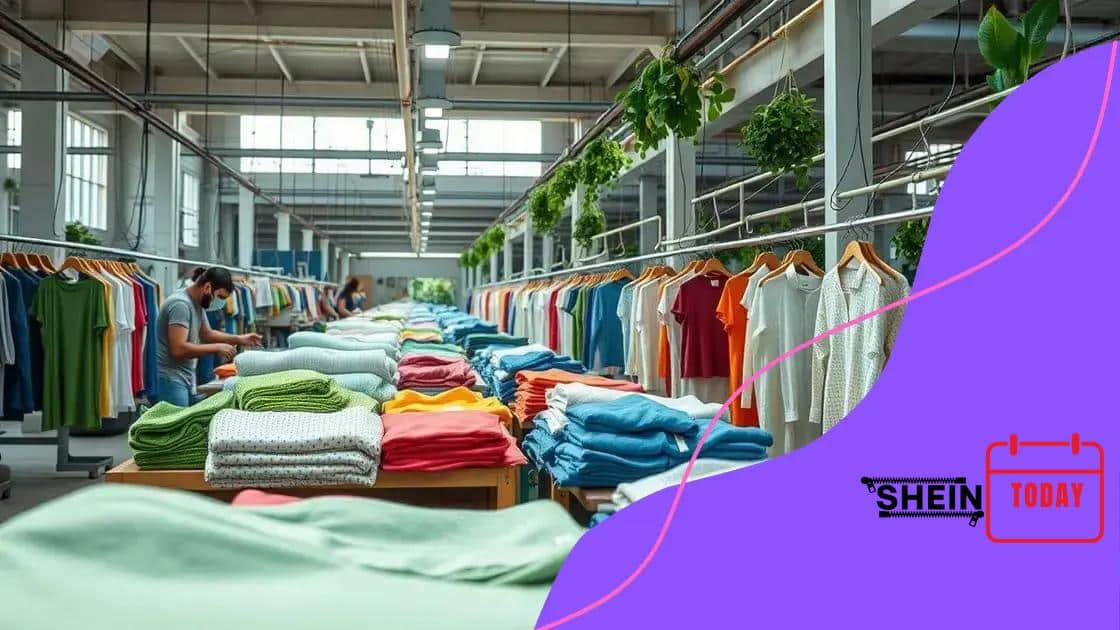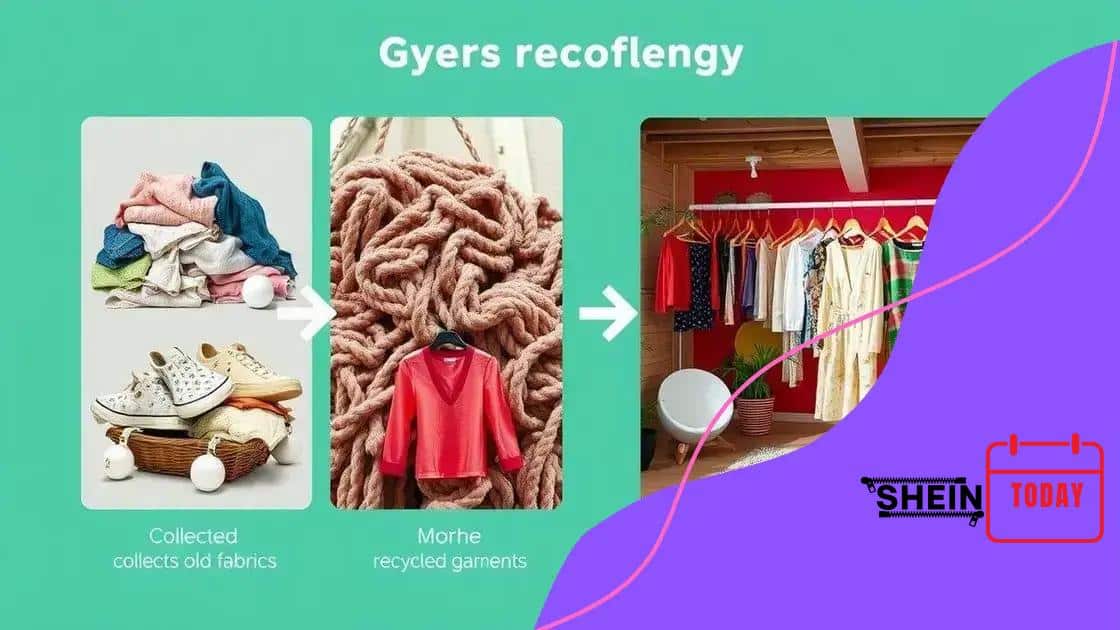How Shein is embracing sustainable clothing production

Shein is embracing sustainable clothing production by using eco-friendly materials, implementing innovative recycling practices, and committing to transparency in its supply chain to meet growing consumer demands for sustainability.
How Shein is embracing sustainable clothing production reflects a growing trend in the fashion industry. Have you noticed more brands committing to eco-friendly practices? Let’s explore what this means for the environment and consumers.
The importance of sustainability in fashion
The importance of sustainability in fashion cannot be overstated. As consumers become more aware of their environmental impact, the fashion industry is facing growing pressure to adapt. Sustainable practices not only benefit the planet but also resonate with modern shoppers who prefer brands that prioritize eco-friendliness.
Why Sustainability Matters
Many people don’t realize the profound effect that clothing production has on our environment. The fashion industry is known for its heavy use of resources, contributing to pollution and waste. Sustainable fashion aims to reduce this impact by emphasizing responsible sourcing and production.
Key Benefits of Sustainable Fashion
- Reduces environmental degradation
- Supports fair labor practices
- Encourages innovation in sustainable materials
- Enhances brand loyalty among eco-conscious consumers
When brands choose to implement sustainable practices, it creates a ripple effect throughout the industry. For example, companies that use organic materials and optimize supply chains inspire others to follow suit. This shift not only benefits the planet but also fosters a community of collective responsibility.
Moreover, sustainability creates opportunities. Innovative brands can attract consumers looking for ethical options. When selecting materials, companies can opt for recycled fabrics, which further reduces waste. By prioritizing sustainability, the fashion industry moves toward a future that values both style and responsibility.
Overall, recognizing the importance of sustainability in fashion is a crucial step in fostering a positive change. As we support brands that align with eco-friendly values, we pave the way for a more sustainable future.
How Shein sources sustainable materials
How Shein sources sustainable materials is pivotal to its commitment to eco-friendly fashion. The brand recognizes that sourcing responsibly is essential for reducing its overall environmental impact. This approach not only meets consumer demand for sustainable options but also helps protect the planet for future generations.
Key Sustainable Materials Used
One of the first steps in sourcing sustainably is selecting materials that are less harmful to the environment. Shein emphasizes the use of fabrics such as:
- Organic cotton, which avoids harmful pesticides.
- Recycled polyester, made from plastic bottles to reduce waste.
- Lyocell, produced from eucalyptus trees in a closed-loop process.
- Bamboo, known for its fast growth and minimal resource needs.
By incorporating these materials, Shein is moving toward a more sustainable production model. But sourcing is just one part of the equation. The company also focuses on the entire supply chain. Working closely with suppliers ensures that best practices are followed at every step.
Shein employs rigorous assessments of its suppliers to guarantee that they adhere to environmentally friendly practices. For instance, they often require documentation that shows compliance with sustainability standards. This not only promotes responsibility but also strengthens partnerships that value eco-conscious initiatives.
Furthermore, innovation plays a big role in sourcing materials. Shein invests in research to identify new sustainable alternatives. This continuous improvement helps the brand keep pace with the evolving landscape of sustainable fashion. The focus on sustainability helps Shein cater to an increasingly eco-aware consumer base who seeks transparency and ethical practices.
Innovative recycling practices at Shein

Innovative recycling practices at Shein highlight the brand’s commitment to sustainability in the fashion industry. As part of its eco-friendly initiatives, Shein focuses on reducing waste through creative recycling methods. These practices not only help to lessen the environmental impact but also promote the concept of a circular economy.
Key Recycling Innovations
One of the standout initiatives Shein has implemented is the use of recycled materials in many of its products. This process involves collecting discarded fabrics and transforming them into new, stylish clothing. The key innovations include:
- Fabric Recycling: Old clothing is repurposed to create new garments, minimizing waste.
- Design for Disassembly: Pieces are designed to be easily taken apart, making future recycling simpler.
- Innovative Collection Programs: Shein encourages consumers to return their old garments for recycling in exchange for discounts, enhancing consumer participation.
- Sustainable Packaging: Using recycled materials for packaging reduces plastic use.
These practices signify a shift in how fashion brands deal with production and waste. By rethinking traditional methods, Shein is not just reducing its carbon footprint but also leading others in the industry to consider similar pathways.
Moreover, Shein collaborates with various environmental organizations to improve recycling efforts. This partnership allows for sharing resources and expertise, further enhancing their program. By committing to transparency in its practices, Shein builds trust with its consumers and sets a new standard in fashion sustainability.
As the demand for eco-friendly clothing grows, Shein’s innovative recycling practices position it as a key player in transforming the future of fashion. People are increasingly drawn to brands that prioritize sustainability, and Shein is actively answering that call.
Consumer impact on sustainable fashion
Consumer impact on sustainable fashion is significant and continues to grow. As buyers become more eco-conscious, their choices drive the fashion industry toward sustainability. This shift not only affects brand practices but also shapes the market landscape.
Demand for Transparency
Modern consumers are increasingly demanding transparency from brands about their sourcing and production methods. They want to know where their clothing comes from and how it was made. This knowledge empowers shoppers to make informed decisions and encourages brands to adopt sustainable practices.
Supporting Ethical Brands
Many consumers actively choose to support brands that prioritize ethical production. This switch to sustainable options can include buying from companies that:
- Use organic materials or recycled fabrics.
- Implement fair labor practices in their supply chains.
- Reduce carbon emissions in their manufacturing processes.
- Commit to charitable initiatives that benefit the environment.
By choosing these brands, consumers help push the entire industry towards more ethical standards. Their purchasing power sends a strong message that sustainability is not just a trend but a necessary shift.
Additionally, social media plays a crucial role in amplifying consumer voices. Platforms like Instagram and TikTok enable individuals to share their views and experiences with sustainable fashion. Influencers often promote eco-friendly brands, creating a ripple effect that increases visibility and sales for these companies.
As consumers advocate for sustainable fashion, they also educate others about the importance of eco-friendly practices. Discussions about the impact of fast fashion on the environment raise awareness and foster a culture of responsibility.
Future goals for eco-friendly production
Future goals for eco-friendly production are essential for brands like Shein to embrace. As awareness of environmental issues rises, the fashion industry must adapt to meet new demands for sustainability. Setting strong objectives helps guide brands in making impactful changes.
Commitment to Sustainable Materials
One primary goal for the future is to increase the use of sustainable materials. Shein aims to enhance its range of eco-friendly fabrics by:
- Expanding partnerships with suppliers of organic cotton and recycled fibers.
- Investing in new technologies for producing fabrics with lower environmental footprints.
- Reducing reliance on fossil-fuel-derived materials, like conventional polyester.
This commitment lays the foundation for a greener product line and encourages other brands to do the same.
Enhancing Waste Management
Another important goal is to improve waste management practices. Shein plans to implement innovative strategies to minimize waste throughout its supply chain. These strategies may include:
- Recycling production scraps and damaged items back into the manufacturing process.
- Implementing a take-back program for customers to return old clothing for recycling.
- Using advanced data analytics to optimize distribution and reduce overproduction.
Such initiatives enhance sustainability and contribute to a circular economy model, where waste is minimized.
Additionally, Shein is focused on enhancing transparency in its supply chain. This goal includes regularly publishing sustainability reports that detail environmental impacts and progress towards eco-friendly objectives. By openly sharing information, Shein aims to build consumer trust and strengthen its commitment to sustainable fashion.
With a clear vision for the future, Shein is dedicated to leading the charge for eco-friendly production in the fashion industry. As brands strive to meet these goals, consumers can expect to see more environmentally responsible options in upcoming collections.
FAQ – Frequently Asked Questions about Shein’s Sustainable Fashion
What materials does Shein use for eco-friendly production?
Shein uses sustainable materials like organic cotton and recycled fabrics to minimize environmental impact.
How does Shein recycle old clothing?
Shein has implemented programs that allow customers to return old garments for recycling, promoting a circular fashion model.
Why is transparency important for sustainable fashion?
Transparency helps consumers make informed choices and encourages brands to adopt ethical practices throughout their supply chain.
What future goals does Shein have for sustainability?
Shein aims to increase its use of sustainable materials, enhance waste management, and improve transparency in its production practices.





